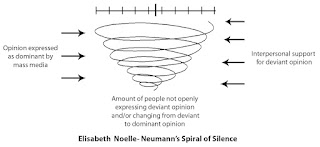The Spiral of Silence Theory
The Spiral of Silence concept has significant implications for society in a number of ways. Positively, it emphasizes how critical it is to understand how people discuss social pressures to voice their opinions and how public opinion is shaped. This understanding can help develop rules and regulations that support diversity, defend the rights of minorities, and encourage public debate. It also stresses how important communication and the media are in forming public opinion and social norms.
However the theory also has a lot of significant flaws. It indicates that minority opinions might be continuously ignored, which might prevent a number of ideas from being considered during decision-making processes. This may undermine democratic values by narrowing the variety of concepts and solutions discussed in public conversations. Additionally, people may be discouraged from speaking up on significant problems by their fear of social rejection or negative consequences, which could have a restricting impact on free speech, as we talked about earlier this summer semester.
Different communities may be affected differently by the Spiral of Silence. The experiences of individuals expressing different points of view can be influenced by various factors such as their socioeconomic status, age, gender, sexual orientation, and cultural background. For example, marginalized groups like LGBTQ+ individuals, women, and individuals of ethnic minorities may encounter greater societal pressure to adopt mainstream viewpoints, which contributes to feelings of exclusion.
![]() The Spiral of Silence can have a variety of personal effects on individuals, households, and social groups. People who discuss their views and values in regard to perceived public opinion may find it influencing their social interactions, employment decisions, and personal decision-making. Differing viewpoints on touchy subjects can cause conflict or discourage specific conversations within communities, which can have an impact on the dynamics of relationships. Depending on current events and generational experiences with social conformity and disagreement, views toward societal norms and values may change over the course of a generation.
The Spiral of Silence can have a variety of personal effects on individuals, households, and social groups. People who discuss their views and values in regard to perceived public opinion may find it influencing their social interactions, employment decisions, and personal decision-making. Differing viewpoints on touchy subjects can cause conflict or discourage specific conversations within communities, which can have an impact on the dynamics of relationships. Depending on current events and generational experiences with social conformity and disagreement, views toward societal norms and values may change over the course of a generation.
I believe, as a society, we have made a lot of progress, and many individuals and groups feel more comfortable speaking out. However, with certain controversial topics such as politics, mental health, women's rights, (etc) we, as a whole, have a lot more work to do. Ways to encourage people to speak up include: promoting diversity and inclusion as well as media literacy, encouraging open dialogue, and challenging societal norms.
This theory drawn: https://www.youtube.com/watch?v=Vq4lPwK2Yk0



Comments
Post a Comment